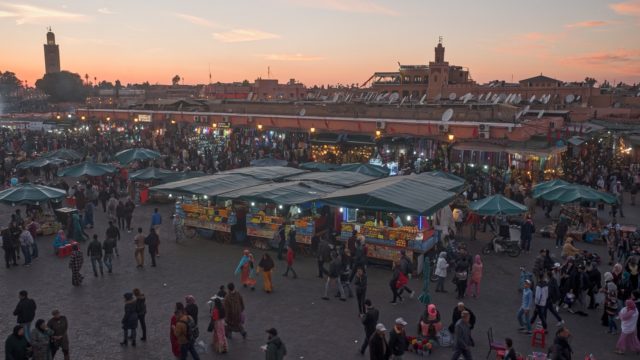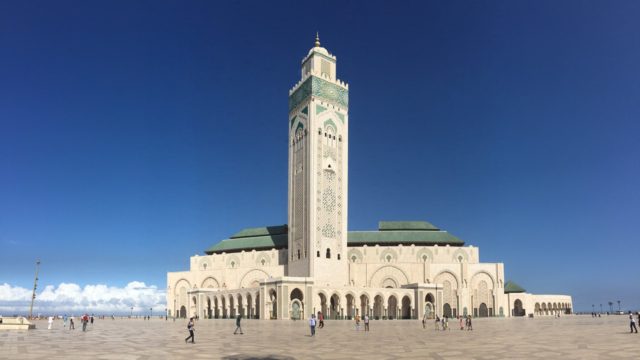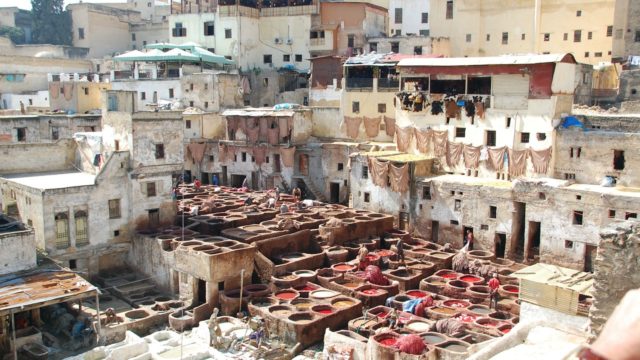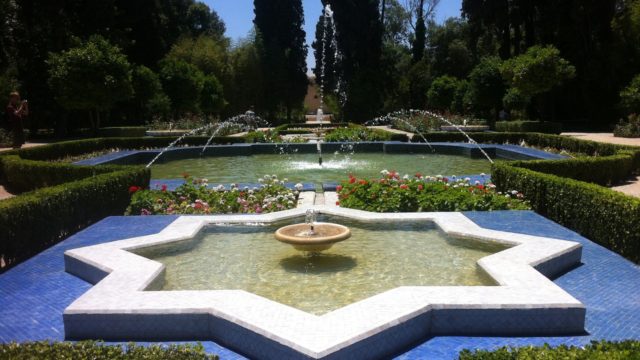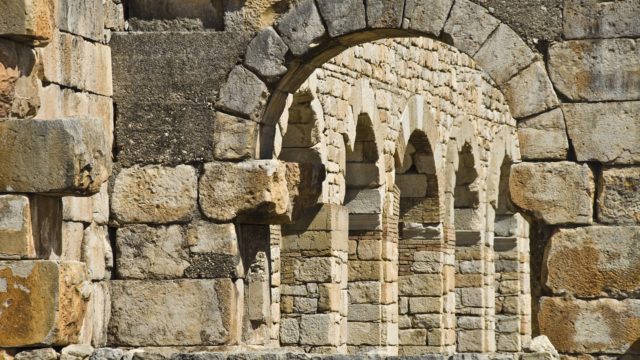There's only one word to define Morocco: magical.
- After arrival to Casablanca you will be privately transferred to your Hotel.
- Short visit to Meknes, a fascinating Imperial City which is magnificently positioned on a hill.
- Visit to Volubilis with its inhabited ruis since 40 BC. Later visit to Moulay Idriss, which is the holy town built to the east. Here Idriss converted the remaining Christians and Jews.
- Full day guided tour of Fez.
- Full day of Fez at your leisure.
- Visit Ifrane & Beni Mellal.
- Enjoy cooking class in Marrakesh.
- Visit The Jewish Quarter (Or the “Mellah”). It’s an extensive quarter reflecting the Jewish community’s historic importance to the city.
- Visit The Ramparts (City Walls) built in the XII century and subsequently destroyed and rebuilt, are about 15 kilometres long, reddish in colour and two meters thick.
- Visit The Koutoubia Mosque, one of the biggest mosques in the Western Muslim world.
- The minaret of the Koutoubia, a square tower made of rose-colored sandstone (67.5meters high, 12.5meters wide) adorned with a delicate sculptured decoration that seems just like lacework on stone.
- Visit The Souks (Bazaars), the vital heart of the Medina, the old part of the city which dates back to the XII century.
- Djemaa El Fna Square, a large open space or rather, a big stage, vaguely triangular in shape, where you can see countless shows performed by jugglers, snake charmers, dancers and acrobats every day.
- Enjoy a balloon safari in Marrakesh. On the instruction of the pilot to his ground crew of “lâchez tout” -‘cast off’ – the magic moment arrives as we rise vertically up towards the Moroccan heavens.
- Enjoy a relaxing visit to The Majorelle Garden, a botanical garden in Marrakech, Morocco.
Day 1. (Sunday) USA / Casablanca
Early this evening make your own way to the airport for the non stop flight to Casablanca.
Overnight: En Route.
Day 2. (Monday) Arrive Casablanca / Meknes / Volubilis / Moulay Idriss / Fez. (Private full day drive) .
arrival in Casablanca today, clear immigration. Collect your luggage and proceed through customs to the exit where you will be met and transferred by a private mini van and English speaking driver to Fez. (With multiple stops en route). You will follow the coastal route north passing through the small capital city of Rabat and then the road goes east to Meknes. On arrival at Meknes, your driver will introduce you to your private guide. Set out on a fascinating visit of the Imperial City of Meknes which is magnificently positioned on a hill.
Break for a late lunch (on your own account) at a place discussed with your guide.
This afternoon continue to Volubilis & Moulay Idriss. At the foot of the mountains lie the roman ruins of Volubilis, inhabited by the Romans around 40BC. Today you will explore the awesome ruins. Next and nearby is the town of Moulay Idriss which is the holy town built to the east. Here Idriss converted the remaining Christians and Jews.
Say goodbye to your guide as we drive with your private driver to Fez reaching by sunset in time to check in to the hotel with the evening free to have dinner and go to sleep early tonight.
Overnight: Sofitel Fès Palais Jamaï
Day 3. (Tuesday) Fez.
This morning after breakfast, your private guide will collect you and proceed on a mixture of driving to various gates and then touring by foot through the old and ancient parts of Fez.
The endless labyrinth of Fez’s narrow streets conceal as many as a thousand derbs (blind alleys). In 1976 UNESCO declared the Fez medina one of the world’s cultural treasures. Currently, they are working on programs to curb pollution and protect the beautiful city.
During the tour, you will see the Merinid Medersa which is also a mosque and is always busy. As the only religious building in Morocco open to non-Muslims, it was exempt from the decree issued by General Lyautey in 1921, which stated that religious establishments were only to be used for study and prayer. The Medersa Bou Inania which was constructed by the Sultan between 1350 and 1357.
Next, visit The Kissaria, which stands on the site of a lunatic asylum built by the Sultan Abou Youssef Yacoub in the 13th century. Today the market is renowned for embroidery, silks and brocades. Departing from the Kissaria will lead you directly to the horm, the sacred wall surrounding the The Moulay Idriss II Zaouia. Constructed in the 9th century and rebuilt in 1437, pilgrims are permitted to touch the tomb of Moulay Idriss II through a hole in the copper plaque.
A typical Moroccan meal is suggested in one of the restaurants set up in the fine houses that dot the old city (lunch on your own account).
This afternoon visit around the Kairouyine Mosque, visit various sites which leads into Rue des Teinturiers which was originally occupied by Dyers of the leather works, but now the area is occupied by metal works. Visit the Place Seffarine next door, whose marble fountain is decorated with fleur-de-lis carved by French convicts who built it in the 16th century.
Not far is Chouara, the colorful Tanners quarter, which spreads out on the banks of the Oued Fez. The view from the rooftops is a memorable one. Clusters of stone vats filled with red, yellow, blue and brown dyes and skins hanging ready drying in the sun.
Next you will take a tour through The Andalous Quarter & Mosque, which is a simple place of prayer built in the 9th century by Meriem one of El Kairouani’s daughters. In 956, the Caliph of Cordoba paid for a minaret to be added, identical to that of the rival Kairouyine Mosque.
Finally today, you will end your tour in The Jewish Quarter (or the “Mellah”). The term Mellah refers to a Jewish quarter of a Moroccan town and comes from the Arabic word – Melh (Salt). According to one story, the Jews were responsible for draining and salting the heads of decapitated rebels before impaling them on the gates of the town.
Overnight: Sofitel Fès Palais Jamaï – (B)
Day 4. (Wednesday) Fez. (Day at leisure to explore)
The entire day is free for you to explore Fes on your own. We recommend when exploring on your own to remember the two main streets inside the old city and not stray too far off them or you will get lost in the maze. The two streets are Talaa Kebira (Upper Ascent) and Talaa Seghira (lower Ascent). What most adventurers do is take one of these routes in the morning, and exploring a short walk down inside the side streets remembering to come back to the main ascent. Continue on the main street and when you find an interesting side street, explore but come back out again to the main street. Dozens of Palaces are hidden away in obscure cul-de-sacs throughout Fez.
Repeat this process to the other main ascent in the afternoon and you will find this one of the most fascinating days spent as you explore the Old City on your own.
Overnight: Sofitel Fès Palais Jamaï – (B)
Day 5. (Thursday) Fès / Ifrane / Beni Mellal / Marrakech. (Private drive)
This morning after an early breakfast, check out of the hotel where you will be met and escorted by your private mini van and driver and set on a full-day drive to Marrakech stopping along the way as you find interesting sights.
Departure from Fes, climb the cedar covered slopes of the Middle Atlas Mountains to Imouzzer, dominating the plain of the river Sebou, through the hill station of Ifrane with its pine and cedar trees.
Continue through Azrou with its old Kasbah and handicraft center, and on to Kenifra and finally into Beni Mellal.
Beni Mellal is a city with 170,000 inhabitants (2005 estimate) along the foot of the Middle Atlas Mountains, overlooking the Beni Amir plain. It is the capital of Tadla – Azilal region with 1.45 million inhabitants (2004 estimate) and an area of 17,125 km², Beni Mellal is the market centre for a region producing a variety of agricultural products, like oranges, olives, figs and other fruits, along with livestock. The region has an advantageous location in the center of road network linking the major urban poles of the country (Casablanca, Marrakesh, Fes and Rabat)
The main attraction is the 17th century Kasbah called Bel-Kush, next to the city entrance. Here we will stop to visit the Kasbah and then break for lunch at a typical Moroccan Restaurant of your choice on your account.
This afternoon we continue our drive south to Marrakech arriving late this afternoon. Check in to the hotel and relax this evening.
Overnight: La Maison Arabe Hotel – (B)
Day 6 (Friday) Marrakech. (Morning Cooking Class & Afternoon Half day tour)
This morning you will enjoy a cooking class at the hotel.
The legendary restaurant at La Maison Arabe today offers cooking workshops designed for the amateur and professional alike. The workshops are conducted by a dada (traditional Moroccan cook) or a chef from our Moroccan restaurant, and are held either at the hotel or at the casbah of our Country Club. Small groups of maximum 8-10 participants work alongside a translator (Arabic/English/French), using easy-to-use modern equipment found in everyday kitchens. At the end of each workshop, participants dine on the meal they have prepared**. At a typical half-day workshop, one learns to prepare an appetizer and a main dish, or a main dish and dessert.
This afternoon enjoy a half day visiting the Jewish sights including the synagogue in the old section.
Enjoy your tour in The Jewish Quarter (or the “Mellah”). The term Mellah refers to a Jewish quarter of a Moroccan town and comes from the Arabic word – Melh (Salt). According to one story, the Jews were responsible for draining and salting the heads of decapitated rebels before impaling them on the gates of the town. The Mellah was created in 1558. This lies south of the Bahia Palace and to the west of the El Badi Palace. It’s an extensive quarter reflecting the Jewish community’s historic importance to the city, when they were involved in the sugar trade and banking, as well as providing most of the jewelers, metalworkers and tailors.
Overnight: La Maison Arabe Hotel – (B,L)
Day 7 (Saturday) Marrakech. (Full day tour)
Marrakech: There’s only one world to define it: magical… There are a thousand legends which describe its history, which began in 1070 when the Saharan Almoravid Abu Baker, the leader of a powerful army, encamped in the plain of Haouz, at the base of the upper Atlas Mountains. Marrakech, the capital of the south, has a mysterious and seductive air. Marrakech, a name with a magical sound that evokes palm groves and caravans, oriental markets, international spies, and duels to the death in an oasis of peace.
We start the tour at 10:00am where your private guide will collect you to begin a full day exploring Marrakech.
The Ramparts (City Walls): The city walls of Marrakech, built in the XII century and subsequently destroyed and rebuilt, are about 15 kilometres long, reddish in colour and two meters thick.
The Koutoubia Mosque: The Koutoubia is one of the biggest mosques in the Western Muslim world. Its Hispano-Moorish style is of an apparent simplicity combined with discreet luxury. This masterpiece was built by the Almohads in one of its imperial cities. Koutoubia in Arabic means “the mosque of booksellers” because once, the surrounding shops were mostly dedicated to the sale of books and antique manuscripts (XII – XIII centuries).
The minaret of the Koutoubia: It’s a square tower made of rose-colored sandstone (67.5meters high, 12.5meters wide) adorned with a delicate sculptured decoration that seems just like lacework on stone. The minaret is topped by a lantern, decorated and square, as well as a ribbed cupola. The 5-to-1 proportion between the height and width of the minaret of the mosque bestows a perfect harmony to this masterpiece of Hispano-Moorish art which was taken as a model for the Giralda in Seville.
The Souks (Bazaars): The souk district of Marrakech is the vital heart of the medina, the old part of the city which dates back to the XII century. It is the place where age-old customs and traditions have been coming together since ancient times.
Later we set out to discover the main square of Marrakech, around 5:00pm when it is the most lively and animated.
Djemaa El Fna Square: It’s a large open space or rather, a big stage, vaguely triangular in shape, where you can see countless shows performed by jugglers, snake charmers, dancers and acrobats every day. Each one marks off his “halqa”, an imaginary circle blessed by a holy man, and presents his show.
Overnight: La Maison Arabe Hotel (B)
Day 8 (Sunday) Marrakech. (Balloon Safari – 5:30am / 12:00pm)
This morning you will be met at your hotel and transferred (between 5:30 and 6:00am according to the season) in a leather-seated 4 wheel drive vehicle to the launch site chosen for that morning.
Once there, the balloon is prepared for flight – and we hope you’ll take part in the fun – you board your gondola and, on the instruction of the pilot to his ground crew of “lâchez tout” -‘cast off’ – the magic moment arrives as we rise vertically up towards the Moroccan heavens. We are followed by a chase vehicle, in constant radio communication with the pilot and whose crews establish the day’s most suitable landing site. Once we land our 4 wheel drive is awaiting us. Take a tour of some of the Berber villages we have over-flown. Stop and have a glass or two of mint tea, some Moroccan pastries or fresh bread dipped in olive oil, in a Berber home. At around midday, you will be taken back to your hotel in Marrakech, armed with a Certificate and a basketful of delightful memories to show your friends and family back home that ‘We’ve been there’. Note: It Is Recommended You Bring: a woollen sweater for early morning departure and flight; sunglasses; sun block; camera.
Late this morning enjoy a relaxing visit to The Majorelle Garden. It is a botanical garden in Marrakech, Morocco. It was designed by the expatriate French artist Jacques Majorelle in 1924, during the colonial period when Morocco was a protectorate of France. Though Majorelle’s gentlemanly orientalist watercolors are largely forgotten today (many are preserved in the villa’s collection) the garden he created is his creative masterpiece. The special shade of bold cobalt blue which he used extensively in the garden and its buildings is named after him, bleu Majorelle.
The afternoon is at leisure back at your hotel.
Overnight: La Maison Arabe Hotel – (B)
Day 9 (Monday) Marrakesh / Casablanca / USA.
Early this morning we transfer to the airport for a short one hour flight to Casablanca. Proceed to the departure gate to relax until your flights to USA.
Overnight: En Route USA (B)
PLEASE REQUEST A QUOTATION.
- Accommodation in Hotels as stipulated in the Itinerary.
- Transportation between atractions and point of interest as stipulated in the itinerary.
- Services of an English speaking guide, park entrance fees and point of interest as indicated in the itinerary.
- All Government taxes and levies.
- All meet and greet services.
- 24 hours stand-by contact number.
- Meals as indicated in the itinerary. (B = Breakfast / L = Lunch / D = Dinner)
- Air transfer between different cities as schedule in itinerary.
- river trip by boat and/or cruise as stipulated in itinerary.
- Transfer to/from Hotel and accommodation.
- All items of personal nature e.g. telephone call bills, fax/email bills etc.
- Gratuities and Tips to Hotels/Lodges/Camps staff and Driver/Guide(s).
- Alcoholic and nonalcoholic drinks.
- Any local or international flight/s and departure taxes and other taxes.
- Laundry services.
- Flights – National or International – (Local flights – Subject to your program)
- Concession fees (In case of any new fees introduce by parks without our knowledge.
- Any other item(s) not included in our itinerary.
- Visa fees and visa processing (Information available at time of reservation).
- Travel Insurance – We highly recommended you to have your personal travel insurance.

